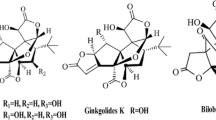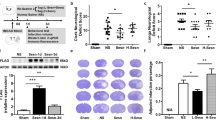Abstract
Panaxatriol saponins (PTS) have a long history in the treatment of stroke. In our previous experiments, PTS has been found to alleviate ischemic stroke and play a role through regulating the inflammatory response, but the specific mechanism of its regulation is still unclear. Cell viability was determined by MTT assay. Expressions of polarization-related proteins CD16, CD68, ARG1 and CD206; inflammatory factors interleukin-1β (IL-1β); inducible nitric oxide synthase (iNOS); monocyte chemotactic protein 1(MCP-1) and cyclooxygenase-2 (COX-2); apoptosis-related proteins pro-caspase3; bax; caspase3 and bcl-2; and STAT3 and p-STAT3 were detected by western blot. ELISA was used to detect the expression of inflammatory-related factors in cells. The apoptosis rate was detected by flow cytometry. We found that the survival rate of oxygen sugar deprivation/reoxygenation (OGD/R) cells increased obviously after PTS treatment in a dose-dependent manner. PTS can promote M2 polarization of microglial cells (BV2) and inhibit inflammatory response of OGD/R cells, accompanied by decreased expression of inflammatory factors IL-1β, iNOS, MCP-1, and COX-2. PTS inhibited apoptosis of OGD/R cells and was accompanied by decreased expression of apoptotic proteins Bax and caspase3 and increased expression of Bcl-2. We also found that PTS activated STAT3 levels in BV2 cells. After the addition of STAT3 inhibitor Stattic, it was found that PTS could promote M2 polarization of BV2 cells by activating the STAT3 pathway, thus inhibiting cell inflammation and apoptosis. PTS promoted M2 polarization in microglia cells by activating the STAT3 pathway, thereby reducing cell inflammation and apoptosis after glucose/oxygen deprivation.








Similar content being viewed by others
References
Erbguth, F. 2017. Stroke Mimics and Stroke Chameleons: Differential Diagnosis of Stroke. Fortschritte der Neurologie-Psychiatrie 85 (12): 747–764.
He, L., X. Chen, M. Zhou, D. Zhang, J. Yang, M. Yang, and D. Zhou. 2011. Radix/rhizoma notoginseng extract (sanchitongtshu) for ischemic stroke: a randomized controlled study. Phytomedicine 18 (6): 437–442.
Luo, F.C., S.D. Wang, L. Qi, J.Y. Song, T. Lv, and J. Bai. 2011. Protective effect of panaxatriol saponins extracted from Panax notoginseng against MPTP-induced neurotoxicity in vivo. Journal of Ethnopharmacology 133 (2): 448–453.
Yang, B.R., S.J. Hong, S.M.Y. Lee, W.H. Cong, J.B. Wan, Z.R. Zhang, Q.W. Zhang, Y. Zhang, Y.T. Wang, and Z.X. Lin. 2016. Pro-angiogenic activity of notoginsenoside R1 in human umbilical vein endothelial cells in vitro and in a chemical-induced blood vessel loss model of zebrafish in vivo. Chinese Journal of Integrative Medicine 22 (6): 420–429.
Hui, Z., D.J. Sha, S.L. Wang, C.S. Li, J. Qian, J.Q. Wang, Y. Zhao, J.H. Zhang, H.Y. Cheng, H. Yang, L.J. Yu, and Y. Xu. 2017. Panaxatriol saponins promotes angiogenesis and enhances cerebral perfusion after ischemic stroke in rats. BMC Complementary and Alternative Medicine 17 (1): 70.
Huang, Y., et al. 2014. Panaxatriol saponins attenuated oxygen-glucose deprivation injury in PC12 cells via activation of PI3K/Akt and Nrf2 signaling pathway. Oxidative Medicine and Cellular Longevity 2014: 978034.
Zhu, J., Y. Liang, S. Yue, G. Fan, H. Zhang, and M. Zhang. 2017. Combination of Panaxadiol and Panaxatriol Type Saponins and Ophioponins From Shenmai Formula Attenuates Lipopolysaccharide-induced Inflammatory Injury in Cardiac Microvascular Endothelial Cells by Blocking NF-kappa B Pathway. Journal of Cardiovascular Pharmacology 69 (3): 140–146.
Bai, J., and S. Wang. 2014. Panaxatriol saponin ameliorated liver injury by acetaminophen via restoring thioredoxin-1 and pro-caspase-12. Liver International 34 (6): 963.
Pan, J., J.L. Jin, H.M. Ge, K.L. Yin, X. Chen, L.J. Han, Y. Chen, L. Qian, X.X. Li, and Y. Xu. 2015. Malibatol A regulates microglia M1/M2 polarization in experimental stroke in a PPARgamma-dependent manner. Journal of Neuroinflammation 12: 51.
Darsalia, V., S. Hua, M. Larsson, C. Mallard, D. Nathanson, T. Nyström, Å. Sjöholm, M.E. Johansson, and C. Patrone. 2014. Exendin-4 reduces ischemic brain injury in normal and aged type 2 diabetic mice and promotes microglial M2 polarization. PLoS One 9 (8): e103114.
He, Y., X. Ma, D. Li, and J. Hao. 2017. Thiamet G mediates neuroprotection in experimental stroke by modulating microglia/macrophage polarization and inhibiting NF-kappaB p65 signaling. Journal of Cerebral Blood Flow and Metabolism 37 (8): 2938–2951.
Qin, C., W.H. Fan, Q. Liu, K. Shang, M. Murugan, L.J. Wu, W. Wang, and D.S. Tian. 2017. Fingolimod Protects Against Ischemic White Matter Damage by Modulating Microglia Toward M2 Polarization via STAT3 Pathway. Stroke 48 (12): 3336–3346.
Yang, X., S. Xu, Y. Qian, and Q. Xiao. 2017. Resveratrol regulates microglia M1/M2 polarization via PGC-1alpha in conditions of neuroinflammatory injury. Brain, Behavior, and Immunity 64: 162–172.
Qi, H., Y. Huang, Y. Yang, G. Dou, F. Wan, W. Zhang, H. Yang, L. Wang, C. Wu, and L. Li. 2016. Anti-platelet activity of panaxatriol saponins is mediated by suppression of intracellular calcium mobilization and ERK2/p38 activation. BMC Complementary and Alternative Medicine 16: 174.
Yao, X.H., and X.J. Li. 2002. Protective effects and its mechanism of panaxatriol saponins isolated from Panax notoginseng on cerebral ischemia. Zhongguo Zhong Yao Za Zhi 27 (5): 371–373.
Lan, X., X. Han, Q. Li, Q.W. Yang, and J. Wang. 2017. Modulators of microglial activation and polarization after intracerebral haemorrhage. Nature Reviews. Neurology 13 (7): 420–433.
Cherry, J.D., J.A. Olschowka, and M.K. O'Banion. 2014. Neuroinflammation and M2 microglia: the good, the bad, and the inflamed. Journal of Neuroinflammation 11: 98.
Meng, H.L., X.X. Li, Y.T. Chen, L.J. Yu, H. Zhang, J.M. Lao, X. Zhang, and Y. Xu. 2016. Neuronal Soluble Fas Ligand Drives M1-Microglia Polarization after Cerebral Ischemia. CNS Neuroscience & Therapeutics 22 (9): 771–781.
Hu, G.Q., X. du, Y.J. Li, X.Q. Gao, B.Q. Chen, and L. Yu. 2017. Inhibition of cerebral ischemia/reperfusion injury-induced apoptosis: nicotiflorin and JAK2/STAT3 pathway. Neural Regeneration Research 12 (1): 96–102.
Sui, Y., L. Bian, Q. Ai, Y. Yao, M. Yu, H. Gao, A. Zhang, X. Fu, L. Zhong, and D. Lu. 2019. Gastrodin Inhibits Inflammasome Through the STAT3 Signal Pathways in TNA2 Astrocytes and Reactive Astrocytes in Experimentally Induced Cerebral Ischemia in Rats. Neuromolecular Medicine 21 (3): 275–286.
Acknowledgments
The authors would like to thank all the members for the helpful discussions on the manuscript.
Funding
This work was supported by Scientific research project of Wuxi Board of Health (QNRC084) and Scientific research project of Wuxi Board of Health (MS201955).
Author information
Authors and Affiliations
Contributions
All the authors read and approved the final version of the manuscript.
Corresponding author
Ethics declarations
Competing Interests
The authors declare that they have no competing interests.
Ethics Approval and Consent to Participate
Not acceptable.
Additional information
Publisher’s Note
Springer Nature remains neutral with regard to jurisdictional claims in published maps and institutional affiliations.
Rights and permissions
About this article
Cite this article
Li, C., Fan, C., Zhao, J. et al. Panaxatriol Saponins Promote M2 Polarization of BV2 Cells to Reduce Inflammation and Apoptosis after Glucose/Oxygen Deprivation by Activating STAT3. Inflammation 43, 2109–2118 (2020). https://doi.org/10.1007/s10753-020-01278-x
Published:
Issue Date:
DOI: https://doi.org/10.1007/s10753-020-01278-x




